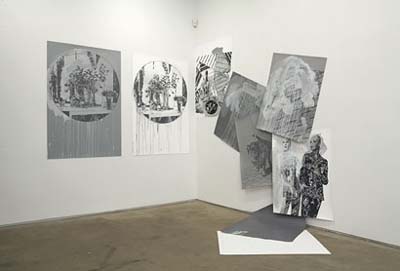 Ilya Lipkin: This Quickened Season, 2007 Acrylic on paper, 9 parts: 2 parts 60 x 40 inches, 7 parts 40 x 32 inches Ilya Lipkin, Sean Raspet, Ned Vena Nature/culture, abstract/representational, poetic/prosaic, public/private, personal/impersonal, political/apolitical, and, of course, modern/postmodern; commonalities like these are linguistically generalizing terms which divide the complex, baffling experience of modern life into simple sets of oppositional spectra. What if, though, the area between these antitheses is not continuous, but is instead characterized by breaks, fissures, and non sequiturs in constant movement, creating uneasy combinations that are irreducible to either term? As Henri Lefebvre has pointed out, it is not that our world isn't defined by contradictions, but that labeling them as such denies their complex and interwoven nature. Sean Raspet's installation, in which archival and art-instructional photocopies face their exact photographic inversions on the opposite wall, is a parody of the idea that such dichotomies provide additional meaning. Just as the exponentially accumulating mass of conflicting images and ideologies adds up to simply more, an image's negative is additive, not subtractive, though in a way that refuses to provide any new information or understanding. All that can be said is the tautological; the opposite of x is the opposite of x, repeated into infinity. In another of Raspet's works, a black plastic box combined with a resin-covered banana peel would seem to be a straightforward contrasting of the human, i.e. garbage, with the natural, or the art object, i.e. the box, with the organic object. However, the "natural" banana peel is carefully presented and preserved as an object for contemplation, while the black box becomes nothing more than an overdone pedestal, or perhaps even a reference to some sort of metaphysical void. The complex relationship between the two elements works against the legitimacy of "nature / culture" as a useful formation. Ned Vena's work also denies simple oppositions in its eerie re-combination of Greenbergian high modernist painting with Minimalist works. A triptych of mirrors etched in acid evidences violent gestures à la Pollock, but also incorporates real, if somewhat obscured or warped space via reflection, like a Smithson mirror box. By ignoring the critical split between a sort of spiritual, detached and transcendental experience of painting and later phenomenological or de-personalized ways of looking, Vena's work reiterates that these theories, far from negating each other or allowing for a reconciliation that incorporates elements of each, have led, at best, to a continual, detached and self-conscious oscillation, and at worst to mere confusion or facile, aestheticizing appeals to beauty. Of all the oppositions that the contemporary work of art has had to navigate, perhaps the most recurrent one is the divide, defined and defended with more or less vehemence, between "art" and "not-art". As Walter Benjamin notes, arguments proposing "art for art's sake" began to emerge in France in the middle of the nineteenth century, just when the novel was becoming a commodity. Cycles of action and reaction in ideology have brought us to a point where this argument again seems dated, but the often adversarial and defensive relationship between art-as-commerce, or design, and the art of Chelsea, Basel, Artforum, and all the rest continues to be redefined both through artistic practice. Ilya Lipkin's work, for example, reproduces images from fashion, textiles, and advertising, symbolically fragmenting their messages and the fantasies they propose by physically obscuring and decontextualizing them. The images look familiar, but they convey no familiarly cohesive meaning, transmitting instead broken, static-filled strings of disconnected adjectives that may or may not have been communicated by the original, purposive photographs and designs; words like "vaguely classical," "elegant," "endearing," or "cute." Lipkin's works co-exist with their source material in their repetitiveness as well as their two-dimensional, poster-like format. In some, a cascade of photocopies quite literally attaches each both to the space of art, that is, the gallery, and to the world of throwaway, endlessly reproduced images for consumption. Ellen Kenney Ilya Lipkin (born 1982 in Riga, Latvia) lives/works in Brooklyn and Malmö, Sweden. Sean Raspet (born 1981) lives/works in Brooklyn; he graduated from the Rhode Island School of Design and will participate in the Whitney Independent Study Program in the fall. Ned Vena (born 1982) lives/works in Brooklyn, and he received a BFA from the School of The Museum of Fine Arts, Boston. Exhibition: June 29 - August 24, 2007 Gallery hours: Mon-Fri 10 am - 6 pm (Summer hours) Cohan and Leslie 138 Tenth Avenue USA-New York, NY 10011 Telephone +1 212 206.8710 Fax +1 212 206.8711 Email info@cohanandleslie.com www.cohanandleslie.com |